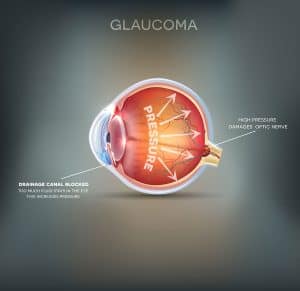
Although glaucoma and cataracts are frequently mentioned together as leading causes of vision loss and blindness, they are very different disorders that affect two completely separate parts of the eye. Once you understand how and why each disease develops, you can see how one is not likely to be mistaken for the other.
It is possible to have glaucoma and cataracts concurrently. Fortunately, under the care of a knowledgeable eye care provider, both cataracts and glaucoma can be appropriately managed. At Laser Eye Center, we give hope to patients diagnosed with cataracts, glaucoma, or both. If you are experiencing symptoms consistent with glaucoma or cataracts, we will ensure that you get a prompt, accurate diagnosis and the right treatment interventions to preserve your sight.
Glaucoma vs. Cataracts – How Are They Different?
Cataracts is a disease of the eye’s lens, and glaucoma is a disease affecting the eye’s optic nerve.
A cataract is a fogging or clouding of the lens that interferes with the focusing of light that enters the eye. When the lens is cloudy, light entering the eye cannot properly focus on the retina at the back of the eye.

Glaucoma occurs when the pressure inside the eye is elevated to levels that are higher than normal. The eye naturally produces and drains a fluid called aqueous humor. However, if the eye overproduces aqueous humor, or the natural drainage mechanisms within the eye become clogged or blocked, fluid can build up in the eye, causing a spike in intraocular pressure. In the more common type of glaucoma, called open-angle glaucoma, this elevation happens slowly over a long period of time. On the other hand, in angle-closure glaucoma cases, the spike happens very quickly. Either way, elevated intraocular pressure levels can damage the optic nerve, which sends visual information from the eye to the brain.
Who Is At Risk?
Most cataracts are related to changes that occur because of the natural aging process. Adults over the age of 60 are at greatest risk of developing cataracts. Other factors, such as prolonged unprotected exposure to UV light, obesity, long-term corticosteroid use, diabetes, and other underlying medical conditions, can contribute to early-onset cataract development.
Glaucoma is also frequently linked to the natural aging process. Individuals over the age of 40 are most likely to develop glaucoma. Other glaucoma risk factors include the following:
- A family history of the disease
- Being of African, Hispanic, or Asian descent
- History of an eye injury
- Pre-existing medical conditions such as diabetes, high blood pressure, or blood circulation problems
Symptoms
Cataract symptoms include blurry vision, poor night vision, sensitivity to light, halos around lights, and colors that appear duller or less saturated than normal.
Most cases of open-angle glaucoma are asymptomatic and do not cause any noticeable changes to vision in the early stages. As the condition progresses, peripheral (side) vision starts to deteriorate and eventually is lost. As mentioned, angle-closure glaucoma comes on very quickly and can cause nausea, vomiting, headaches, eye pain, eye redness, and rapid vision loss. These symptoms should signal the immediate need for medical attention. If angle-closure glaucoma is not promptly treated, rapid vision loss can result.
Cataract Treatment
Cataracts can be cured through surgery to remove the cloudy lens and replace it with an artificial lens implant that facilitates clear vision. Any vision lost to cataracts can be completely restored — or even improved upon — with the placement of a premium intraocular lens. Most of Laser Eye Center’s cataract patients say they not only recover the vision they had prior to cataracts, but that they can see more clearly after surgery than they have in years.
Unlike cataracts, vision lost to glaucoma cannot be restored. Treatments are designed to lower intraocular pressure, stop damage to the optic nerve, and prevent additional vision loss.

There are a range of available treatments for glaucoma, ranging from the daily use of eyedrops to laser or traditional surgery. Depending on the specific class of medicine, eyedrops can reduce the amount of fluid produced in the eye and/or improve the process by which fluid drains from the eye.
Another option for lowering intraocular pressure is minimally invasive glaucoma surgery, or MIGS, which is relatively new in the arena of glaucoma management. During a MIGS procedure, small instruments and devices are used to create new pathways for fluid to drain or to open up any blocked channels that are impeding the normal drainage of fluid. Because the instruments and devices are small, and the surgical incisions are minimal, there is less trauma to the eye’s natural tissues and lower risks of complications.
Can I Safely Undergo Cataract Surgery If I Have Glaucoma?
Actually, you could explore the possibility of a combination surgery to treat cataracts and mild to moderate glaucoma simultaneously. Depending on the severity of the conditions, it is possible to replace the cataract-diseased lens during the same operation that creates a better drainage pathway for excess fluid.
Sometimes cataract surgery is performed concurrently with trabeculectomy, which creates a tiny pocket called a bleb wherein excess fluid can drain, or with the placement of a shunt. Nowadays, some surgeons are combining cataract extraction with MIGS to eliminate or bypass a blockage in the eye’s drainage channels.
Having two procedures performed simultaneously offers several benefits: it is more convenient than undergoing separate surgeries, there are fewer risks, and there are some cost-saving opportunities.
Of course, an experienced cataract surgeon is the best person to advise you about your cataract and glaucoma treatment options. Your surgeon will learn about your ocular health history, ascertain the status of your cataracts and glaucoma progression, and recommend the course of action that seems most reasonable in your specific case. This may be a combination operation, or two operations performed separately.
Contact Laser Eye Center Today
Patients who are concerned about their vision after a cataract and/or glaucoma diagnosis trust their care to Laser Eye Center. See for yourself why we are the leading name in eye care in Los Angeles, the Inland Empire, and beyond. Call or email us today!
Schedule your free consult today
Click here to learn moreGet started on your journey to clearer, crisper vision with Laser Eye Center™. Our expert team of doctors are trained and skilled in the latest technology and methods for laser vision correction. To learn more about our state-of-the-art All Laser LASIK technology or about All Laser LASIK itself, contact us today. Schedule your FREE All Laser LASIK consultation by calling today.

